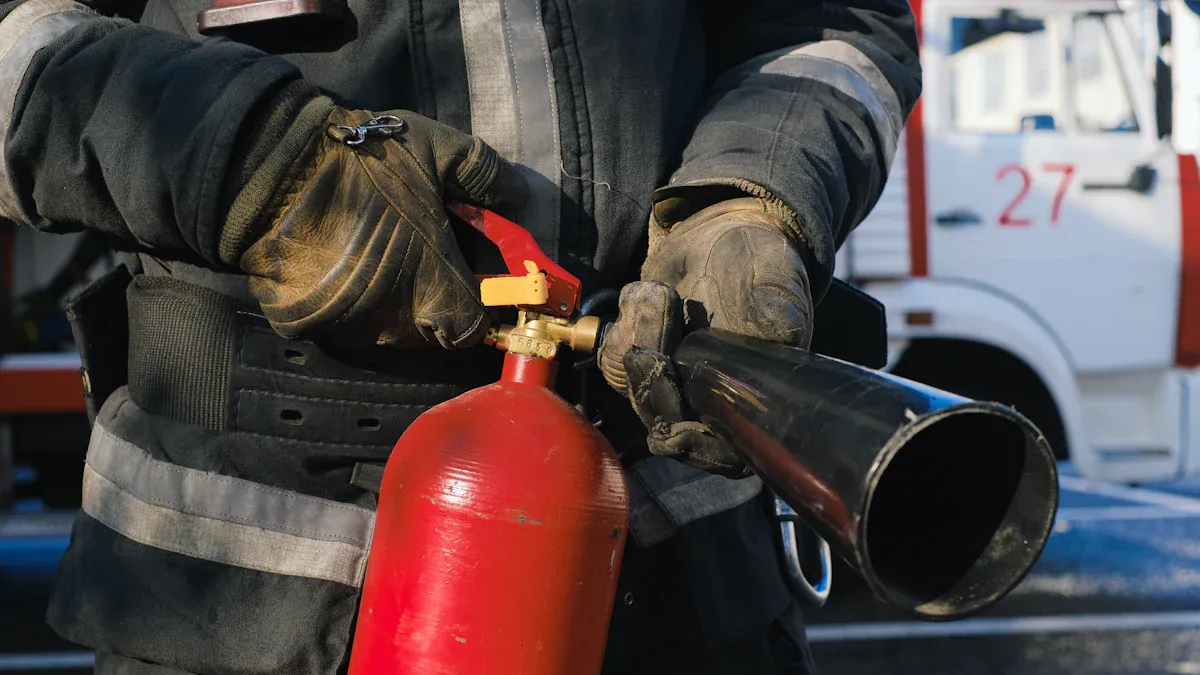
I’ve seen how the US-China tariffs have reshaped global trade, especially for fire equipment exporters. Rising material costs have become a major hurdle. Steel, a key component, now accounts for 35-40% of raw material expenses, with prices up 18% this year. Export restrictions on phosphate-based fire-suppressing agents have further driven costs higher. Additionally, strict regulatory standards like ISO 7165:2020 continue to limit market access, creating challenges for exporters navigating these turbulent waters.
Key Takeaways
- Higher costs from US-China tariffs are hurting fire equipment sellers. Use more suppliers and cut waste to save money.
- New markets like India and Canada have big growth chances. Change your products to fit local needs and growing cities.
- New ideas help you stay ahead. Work on green designs and smart tech to attract buyers and make products better.
Impact of US-China Tariffs on Fire Equipment Exports

Rising Costs for Fire Equipment Exporters
The US-China tariffs have significantly increased costs for fire equipment exporters. Freight expenses have surged across multiple transport methods. For instance:
- Domestic trucking and international shipping costs have risen sharply.
- Container costs have increased by up to 445%, straining supply chains.
- Ongoing port delays and disrupted shipping routes are driving up consumer prices.
These rising costs force exporters to either absorb the financial burden or pass it on to buyers, making their products less competitive globally. The situation has created a challenging environment for businesses trying to maintain profitability while adhering to strict quality standards.
Decline in US-China Trade Volumes
The tariffs have also led to a noticeable decline in trade volumes between the US and China. Many fire equipment exporters have reported reduced orders from Chinese buyers due to higher prices and retaliatory tariffs. This decline has pushed exporters to explore alternative markets, but the transition is not without its hurdles. Establishing new trade relationships requires time, resources, and a deep understanding of local regulations and consumer preferences.
Changing Buyer Preferences and Market Dynamics
The fire equipment market is evolving rapidly, driven by technological advancements and shifting consumer demands. For example:
| Factor | Description |
|---|---|
| Smart Buildings | The adoption of smart buildings is increasing demand for advanced fire alarms and integrated safety solutions. |
| Eco-Friendly Products | Buyers are prioritizing eco-friendly fire equipment to align with sustainability goals. |
| Advanced Detection Systems | Innovations in detection systems are addressing modern fire safety needs. |
Urbanization and rising disposable incomes are also influencing purchasing decisions. Consumers now seek high-quality, sustainable, and technologically advanced fire safety solutions. Exporters must adapt to these trends to remain competitive in the global market.
Challenges Facing Fire Equipment Exporters
Supply Chain Disruptions and Delays
Supply chain disruptions have become a persistent challenge for fire equipment exporters. I’ve noticed that delays in raw material shipments and port congestion often lead to production slowdowns. For example, steel shortages and increased freight costs have made it harder to meet delivery deadlines. These issues not only strain relationships with buyers but also increase operational costs. To mitigate these risks, many exporters are now diversifying their supplier base and adopting digital tools to monitor supply chain performance in real time.
Regulatory and Compliance Barriers
Navigating regulatory and compliance requirements remains a significant hurdle. Each country enforces its own fire safety standards, which can vary widely. For instance, meeting ISO 7165:2020 standards for portable fire extinguishers requires rigorous testing and certification. I’ve observed that smaller exporters often struggle to allocate resources for compliance, which limits their market access. Staying updated on international regulations and investing in compliance expertise can help businesses overcome these barriers.
Increased Competition in Global Markets
The global fire safety equipment market has become increasingly competitive. Strategic collaborations and acquisitions among major players are driving innovation and market growth. Rising awareness of fire hazards and stricter safety regulations have further intensified competition. Additionally, urbanization and industrialization are fueling demand for advanced fire safety solutions. To stay ahead, exporters must focus on product differentiation and customer-centric strategies. Offering eco-friendly and technologically advanced fire equipment can provide a competitive edge in this dynamic market.
Opportunities for Fire Equipment Exporters

Expanding into Emerging Markets
Emerging markets present significant growth opportunities for fire equipment exporters. I’ve observed that countries like India and Canada are experiencing rapid urbanization and industrial growth, which increases the demand for fire safety solutions. For instance:
- Canada faces a growing frequency of wildfires due to environmental changes like dry springs and hot summers. This trend has created a heightened need for firefighting equipment to protect infrastructure and ensure safety.
- India’s real estate sector is projected to reach $1 trillion by 2030, contributing 13% to the GDP. This growth fuels demand for fire safety equipment in residential and commercial buildings.
The global fire safety equipment market is also expected to grow to $67.15 billion by 2029, driven by rising fire risks and the need for eco-friendly solutions. Exporters can capitalize on these trends by tailoring their products to meet the specific needs of these markets.
Leveraging Regional Trade Agreements
Regional trade agreements (RTAs) offer exporters a pathway to reduce costs and expand market access. I’ve seen how free trade agreements (FTAs) have benefited US manufacturers in similar industries. For example:
- In 2015, US manufacturers exported $12.7 billion more in goods to FTA partners than they imported.
- Nearly half of all US-manufactured exports are sold to FTA partners, even though these countries represent only 6% of global consumers.
By leveraging RTAs, fire equipment exporters can gain a competitive edge in key markets. These agreements often reduce tariffs and simplify regulatory requirements, making it easier to establish a foothold in new regions.
Innovating for Cost Efficiency and Sustainability
Innovation plays a crucial role in helping exporters stay competitive. I’ve noticed that buyers increasingly prioritize eco-friendly and cost-efficient fire equipment. Developing products that use sustainable materials or advanced technologies can attract environmentally conscious consumers. For example, integrating smart sensors into fire alarms or using recyclable materials in extinguishers can enhance product appeal.
Additionally, adopting lean manufacturing practices can reduce production costs and improve profitability. Exporters who invest in research and development will be better positioned to meet evolving market demands while maintaining cost efficiency.
Future Outlook for Fire Equipment Exports
Potential Shifts in US-China Trade Policies
I’ve observed that US trade policies are undergoing a strategic transformation. Experts suggest that the US is adopting a more inward-focused approach, prioritizing domestic industries over international trade. This shift could lead to structural changes in the economy, directly impacting sectors like fire equipment. Tariffs may remain a key tool in trade negotiations, creating uncertainty for exporters. However, this evolving landscape also presents opportunities for businesses to explore alternative markets and reduce reliance on traditional trade routes. Staying agile and informed about policy changes will be crucial for navigating these challenges.
Growth in Demand for Fire Safety Equipment Globally
The global demand for fire safety equipment continues to rise, driven by urbanization, stricter regulations, and technological advancements. For example:
- Europe’s regulatory requirements mandate regular upgrades of fire systems, boosting demand.
- The Middle East and Africa’s oil and gas industries are increasing their focus on fire detection systems.
- Latin America’s growing disposable income and public awareness are fueling market growth.
| Region | Growth Factors |
|---|---|
| Asia Pacific | Urbanization, reconstruction efforts, and increased consumer awareness. |
| Europe | Regulatory requirements mandating fire system upgrades. |
| Middle East & Africa | Oil and gas industry driving demand for fire detection systems. |
| Latin America | Rising disposable income and public awareness related to fire safety. |
Emerging markets in Asia-Pacific and Latin America are particularly promising. I’ve noticed that urbanization and industrial activities in these regions are creating a surge in demand for fire equipment. Exporters who tailor their products to meet local needs will gain a competitive edge.
The Role of Technology in Shaping the Industry
Technology is revolutionizing the fire equipment industry. Innovations like IoT-enabled fire detection systems and AI-driven analytics are transforming fire safety. For instance, AI enhances predictive capabilities, enabling faster and more accurate responses to fire hazards. Companies are also integrating drones and robotics to improve operational efficiency and safety.
| Technology | Description |
|---|---|
| Drones | Provide aerial perspectives for assessing fire scenes, enhancing safety and efficiency. |
| Robotics | Perform dangerous tasks, improving safety in hazardous environments. |
| Electric Fire Trucks | Reduce emissions and noise, improving emergency response times. |
| Virtual Reality | Simulates fire scenarios for enhanced training in a safe environment. |
| Artificial Intelligence | Aids in predictive analytics and real-time decision-making, enhancing fire service operations. |
I believe these advancements will not only improve safety but also create new opportunities for exporters to offer cutting-edge solutions. By embracing these technologies, businesses can stay ahead in a competitive market.
The US-China tariffs have reshaped the fire equipment export industry, creating both challenges and opportunities. I believe exporters must prioritize market diversification, leverage regional trade agreements, and invest in innovation to stay competitive.
Post time: Apr-12-2025

